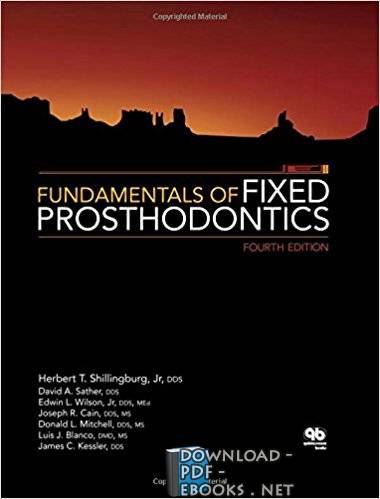Shillingburg Fundamentals Of Fixed Prosthodontics Pdf Free Download
среда 30 января admin 84
Shillingburg Fixed Prosthodontics Of Pdf Doc.pdf Free Download Here Herbert T. Shillingburg, Jr, DDS - Quintessence Publishing! Fundamentals of Fixed. Fundamentals of Fixed Prosthodontics, Fourth Edition. Shillingburg, Herbert T., Jr. It is designed to serve as an introduction to restorative dentistry. Frm part 1 schweser google docs.
كتاب Fundamentals of Fixed Prosthodontics Fourth EditionFundamentals of Fixed ProsthodonticsFourth EditionFUNDAMENTALS OF FIXEDPROSTHODONTICSFOURTH EDITIONHerbert T. Shillingburg, Jr, DDSDavid Ross Boyd Professor EmeritusDepartment of Fixed ProsthodonticsUniversity of Oklahoma College of DentistryOklahoma City, OklahomawithDavid A. Sather, DDSEdwin L.
Wilson, Jr, DDS, MEdJoseph R. Cain, DDS, MSDonald L. Mitchell, DDS, MSLuis J. Blanco, DMD, MSJames C.
Kessler, DDSIllustrations bySuzan E. StonePrefaceFixed prosthodontics is the art and science of restoring damaged teeth with cast metal, metalceramic,or all-ceramic restorations and of replacing missing teeth with fixed prostheses using metalceramicartificial teeth (pontics) or metal-ceramic crowns over implants. Successfully treating apatient by means of fixed prosthodontics requires a thoughtful combination of many aspects of dentaltreatment: patient education and the prevention of further dental disease, sound diagnosis, periodontaltherapy, operative skills, occlusal considerations, and, sometimes, placement of removable completeor partial prostheses and endodontic treatment.Restorations in this field of dentistry can be the finest service rendered for dental patients or theworst disservice perpetrated upon them. The path taken depends upon one’s knowledge of soundbiologic and mechanical principles, the growth of manipulative skills to implement the treatment plan,and the development of a critical eye and judgement for assessing detail.As in all fields of the healing arts, there has been tremendous change in this area of dentistry inrecent years.
Improved materials, instruments, and techniques have made it possible for today’soperator with average skills to provide a service whose quality is on a par with that provided only bythe most gifted dentist of years gone. This is possible, however, only if the dentist has a thoroughbackground in the principles of restorative dentistry and an intimate knowledge of the techniquesrequired.This book was designed to serve as an introduction to the area of restorative dentistry dealing withfixed partial dentures and cast metal, metal-ceramic, and all-ceramic restorations. It should providethe background knowledge needed by the novice as well as serve as a refresher for the practitioner orgraduate student.To provide the needed background for formulating rational judgments in the clinical environment,there are chapters dealing with the fundamentals of treatment planning, occlusion, and toothpreparation. In addition, sections of other chapters are devoted to the fundamentals of the respectivesubjects. Specific techniques and instruments are discussed because dentists and dental techniciansmust deal with them in their daily work.Alternative techniques are given when there are multiple techniques widely used in the profession.Frequently, however, only one technique is presented.
Cognizance is given to the fact that there isusually more than one acceptable way of accomplishing a particular task. However, in the limitedtime available in the undergraduate dental curriculum, there is usually time for the mastery of only onebasic technique for accomplishing each of the various types of treatment.An attempt has been made to provide a sound working background in the various facets of fixedprosthodontic therapy.
Current information has been added to cover the increased use of newcements, new packaging and dispensing equipment for the use of impression materials, and changes inthe management of soft tissues for impression making. New articulators, facebows, and concepts ofocclusion needed attention, along with precise ways of making removable dies.
The usage ofperiodontally weakened teeth requires different designs for preparations of teeth with exposed rootmorphology or molars that have lost a root.Different ways of handling edentulous ridges with defects have given the dentist better control ofThe fourth edition of this popular undergraduate text has been updated and expanded to reflect new research, materials, and techniques in fixed prosthodontics, with the addition of more than 350 new illustrations and three new chapters on the restoration of implants. It is designed to serve as an introduction to restorative dentistry techniques using fixed partial dentures and cast metal, metal-ceramic, and all-ceramic restorations, providing the background knowledge needed by the novice and serving as a refresher for the practitioner or graduate student. Specific techniques and instruments are discussed, and updated information has been added to cover new cements, new impression materials and equipment, and changes in soft tissue management methods used during impression procedures.
